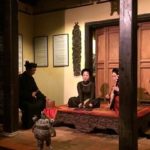Painter Ngoc Linh, aged 93, has recently published a remarkable collection titled “Hanoi I Love”. This publication showcases his exquisite miniature paintings portraying the captivating Hanoi landscape that he masterfully created three decades ago.
The book launch ceremony for the artist’s family’s National Archives Center III took place on October 5th.
The book offers a delightful exploration of Hanoi’s artistic and cultural heritage, featuring a remarkable collection of nearly 140 miniature drawings. Printed in both Vietnamese and English, it provides readers with a unique “pocket-sized Hanoi” experience. Painted in 1991, these drawings beautifully depict the charming landscapes and streets of the capital city, making it a must-have for art enthusiasts and those captivated by the beauty of Hanoi.
| Artist Ngoc Linh in one of his recent exhibitions. |
Ngoc Linh’s Miniature Paintings
Experience the incredible talent of Ngoc Linh through her exquisite oil paintings. Each masterpiece is meticulously created on a miniature scale, with one of the most captivating pieces being her painting on the tiny area of a discarded lottery ticket. Witness the beauty and skill that comes to life in Ngoc Linh’s miniature works.
The artwork is available in two sizes: 7 x 10 cm and 10 x 14 cm (two sheets together). These stunning pieces were created by the artist during his bicycle rides through the streets of Hanoi, capturing the beauty of its hidden corners.
According to the artist, Ngoc Linh, the series of miniatures was created as a personal challenge, rather than due to a lack of canvas. Each painting is meticulously crafted using oil on small paper, allowing for the retention of intricate details while still capturing the generous and youthful spirit that is characteristic of Ngoc Linh’s unique style.
| The Huc Bridge and Hoan Kiem Lake. |
Artist Trinh Lu has curated a collection of miniatures that she believes encapsulate Ngoc Linh’s distinct “contemporary folk” character. These works offer a unique and insightful glimpse into Ngoc Linh’s artistic expression.
The art industry in Hanoi has already witnessed the remarkable presence of the “Pho Phai” paintings by the renowned painter Bui Xuan Phai (1920-1988). And now, adding to its vibrancy, Hanoi is home to the lively “Pho Linh” paintings, which captivate viewers with their playful and melodious essence.
Artist Trinh Lu describes Ngoc Linh as a talented individual who passionately expresses his love for Hanoi through his drawings. Linh’s artistic style brings a youthful and creative perspective to the city, capturing its essence in a series of captivating miniatures. His dedication to his craft has made him an invaluable asset to the art community in Hanoi, and his work showcases the beauty and vibrancy of the city.
Lu is confident that these peculiar miniature artworks will elicit a strong emotional response from viewers, regardless of their familiarity with the medium of painting.
| Temple of Literature. |
“According to artist Trinh Lu, these artworks possess an innocent yet profound beauty, filled with delightful surprises that evoke genuine laughter.”
Ngoc Linh, an artist, finds profound inspiration in these miniature paintings. They serve as distinctive resources for him to produce over 160 derivative artworks in various sizes and materials. These works were featured in the renowned 1995 exhibition titled “Hanoi I Love.”
Only now has he released this collection of miniature models, in the hopes that individuals can cherish and appreciate them wherever they may venture, alongside their deep affection for Hanoi.
| Train guard at Cua Nam Street. |
Ngoc Linh, also known as Vi Van Bich, is a highly esteemed artist belonging to the Tay ethnic group. Born in 1930, he was part of the esteemed Resistance Fine Arts Course (1950-1954). This course was taught by renowned painters To Ngoc Van and Tran Van Can in the Viet Bac resistance war zone.
After the war, Ngoc Linh returned to Hanoi and was appointed to work at the prestigious Vietnam Feature Film Studio. He played a vital role in the art direction of several iconic films in Vietnamese cinema history. Some notable examples include “A Phu Couple” (1959-1972, directed by Mai Loc), “Share a River” (1959, directed by Nguyen Hong Nghi and Pham Ky Nam), and “August Star” (1976, directed by Tran Dac).
Ancient house in Ma May
NDO – Ma May, a rare quarter that still retains several old houses, has created one of the characteristics of Hanoi. Hanoi’s streets are becoming increasingly crowded and traditional features can sometimes be hidden behind modern life. But if one takes the time to relax and look around, the ancient features begin to reveal themselves.











